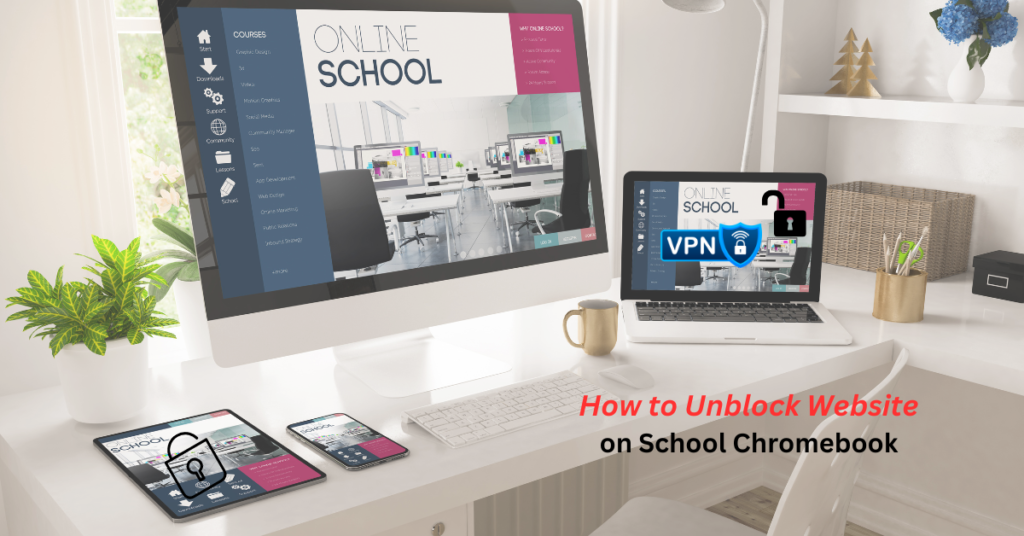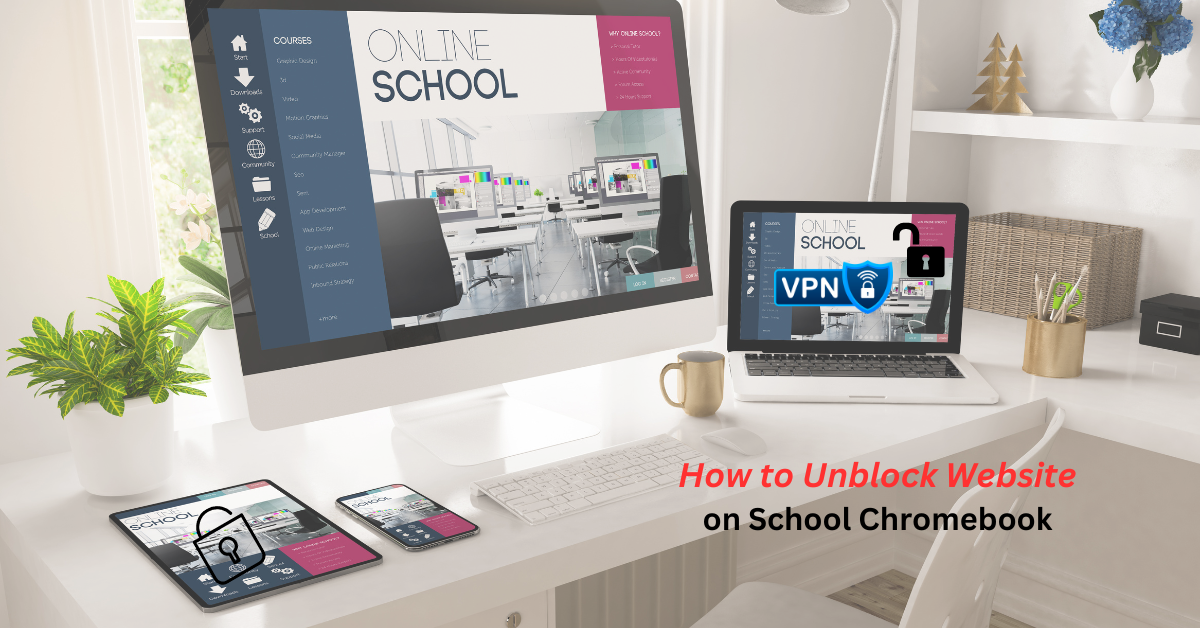Although school Chromebooks are great resources for productivity and learning, their internet limitations can sometimes be a liability. A robust study condition is provided by the blocking of specific websites by many educational institutions. Accessing blocked websites on school-issued Chromebooks can be challenging since they are often locked down for security and monitoring goals.
How to Unblock Website on School Chromebook? However, you can try a few methods to bypass the rules. Accessing blocked content on school-issued Chromebooks can be a challenge, but using a VPN like NordVPN provides a workaround. NordVPN allows you to route your web traffic through an encrypted tunnel to get around restrictions.
However, be aware that VPN usage likely violates school network policies. Use wisely to bypass disciplinary consequences if caught circumventing filters. Outplaying school firewalls is possible with NordVPN’s help.

Why Do School Chromebooks Block Websites?
School Chromebooks block certain websites to limit distractions and restrict access to inappropriate content. School IT administrators set up filters that block sites like social media, gaming, and adult content.
While schools want to keep students focused on learning, overly strict filtering can make it hard to access useful sites for research. To get around blocks, try using a VPN app if allowed.
You may also request certain sites be whitelisted if needed for schoolwork. Overall, website blocks aim to keep students on task, though seeing the right balance of access takes trial and error.
Are VPNs legal?
Yes, VPNs are generally legal to use in most countries. They encrypt your internet traffic and route it through remote servers, protecting your privacy online. However, some repressive regimes have banned or restricted VPNs to censor content and monitor their citizens’ activities.
Using a VPN may also violate company policies on corporate networks. While VPNs have legitimate privacy and security uses, illegal activities can subject you to prosecution regardless of using a VPN.
As long as you use VPNs ethically and obey local laws, VPNs offer a legal way to enhance your privacy and access blocked content worldwide. But be aware of any restrictions based on your location.
How To Unblock Website On School Chromebook?
You can open these digital doors on your school Chromebook with many keys, so don’t worry. When used carefully and under policies, your school Chromebook may become your entryway to an endless world of knowledge.
1. Use a VPN
Some of you may have run into that annoying digital wall when trying to use the school Chromebook to unlock a website. I have a hidden weapon for you if you’ve been struggling to figure out how to solve the problem: a virtual private network (VPN).
Nord VPN is among the greatest in the industry. Millions of people have come to trust this excellent service because of its unique global server fleet, which consists of around 5200 machines.
How To Add a VPN To A Chromebook:
Adding a VPN to your Chromebook is a straightforward process that allows you to encrypt your internet traffic and access region-restricted content. Follow these steps to get connected through a VPN:
First, open the Settings app on your Chromebook. Click on the Network icon or scroll down to the Network section. Look for the option to manage connections and select ‘Add connection’.
You’ll now see the option to add a built-in VPN connection. Choose this to set up your VPN. You’ll need to get the necessary connection details like server address, protocol, and credentials from your VPN provider to fill in here. Make sure to select the right protocol like L2TP or OpenVPN based on what your VPN service uses.
Enter the server address in the format provided by your VPN company. Add in your username and password that you use to log into your VPN account. You can choose to connect automatically or to connect manually each time.
Once all the fields are filled out, click on Connect to initialize the VPN connection. You may need to reopen your browser or apps to route your traffic through the VPN. The network icon will show a small lock symbol when your VPN is active to confirm you are connected.
Use A Proxy Server To Unblocked Websites On The School Chromebook
Schools often block certain websites on their network that they deem inappropriate or unnecessary as distractions. However, you can bypass these restrictions by routing your Chromebook’s traffic through a proxy server.
How to set up a proxy server on a Chromebook:
First, open the Settings application on your Chromebook. Navigate to the Network section and select the Wi-Fi network that you are currently connected to.
Scroll down to the bottom of the Wi-Fi settings page and expand the ‘Proxy’ section. Toggle on the switch next to ‘Allow proxies for shared networks’ and confirm your choice.
Under ‘Connection type,’ change the dropdown menu from ‘Direct’ to ‘Manual proxy configuration.’ This will allow you to enter custom proxy server details.
You now need to enter the proxy server information. This includes the HTTP proxy address and port number, which you can find from public proxy server lists online. Make sure the proxy IP address you use is not blocked by your school.
Enter the proxy server’s IP address in the ‘HTTP Proxy’ field and the corresponding port number in the ‘Port’ field. Leave the HTTPS proxy field blank.
Additionally, you can configure the proxy to bypass the school’s firewall for specific sites only. Enter the URLs you want to access in the ‘Bypass proxy for’ field separated by commas.
Once all the proxy server details are filled in, click ‘Save’ at the bottom to apply the manual configuration. This will route your Chromebook’s web traffic through the proxy server, allowing you to circumvent content filtering and access blocked websites.
Change The Chromebook’s Site Permissions
Although this approach is a little extreme, some of you could find success using it. You can go into the settings and remove any website filters since you have some sort of administrative access to the Chromebook and the school IT department only blacklisted websites at the device level.
How to remove site blocks within the Chromebook Site Settings:
1. Open Chrome.
2. Select the menu button with three dots.
3. Click on Settings.
4. into the tab for security and privacy.
5. Select Site Preferences.
6. Select Insecure material under the Additional Content Options section.
7. Go to the “Not allowed to show insecure content” box and find the website you wish to visit. To remove it, click the three-dot menu button next to it.
8. If it’s not there, navigate to the area that says “Allowed to show insecure content,” click “Add,” type the URL, and press “Add” once again.
Use The Site’s IP Address
Are you aware that every website has an IP address? The domain names are more user-friendly and far simpler to remember. While AndroidAuthority.com is easy to remember, a string of digits and periods is harder to remember.
Schools seldom take the trouble to restrict IP addresses in addition to domains, even though you may still visit websites using the IP address.
To access the website, simply locate its IP address, type it into the address box, and press Enter. You may quickly locate the most often-used IP addresses by doing a Google search for them. You can also use the terminal or command prompt if you’re having trouble doing this.
How to find a website’s IP address using the Chromebook terminal:
1. On your Chromebook, press Ctrl + Alt + T.
2. Type in “PING”, followed by a space, followed by the website you want to access. It should look like “PING www.androidauthority.com”.
3. Hit Enter.
4. The results should show you the IP address in parentheses. In this case, it’s 172.67.2.16.
Try Google Translate
Although this method may seem a little strange, many people seem to have successfully used Google Translate to get around site limitations to access certain websites.
How to use Google Translate to bypass site restrictions:
1. Go to the Google Translate website.
2. Click on Websites.
3. Enter the URL into the text box.
4. Hit Enter or click on the Translate arrow.
You can browse the website after it opens in a new tab. Additionally, nothing will be translated if you leave the language set to English.
Try To Access The Mobile Version Of The Website
Once more, this sounds like a strange way that probably shouldn’t be used to unblock websites on Chromebooks used in schools, yet many people swear by it. They might require an improved IT staff.
The website must have a mobile version to accomplish this, and you must find its mobile URL. Facebook, for instance, has “m.Facebook.com.” In the address bar, type that URL, then press Enter.
Connect through a mobile hotspot
Chromebooks aren’t always strictly restricted. If a website is restricted on the network, you should only be able to access it through the school’s WiFi. This means that if you move to a Wi-Fi network without any restrictions, you can unblock websites on Chromebook laptops used in schools.
You may easily connect your phone to the Chromebook and use the mobile hotspot capability if you have a smartphone and a carrier plan that allows hotspot data. Just be aware that hotspot data is not included in all plans and may cost extra. Find out as much as you can about the specifics of your plan through research.
When you’re prepared, adhere to our instructions on how to configure an Android mobile hotspot. After that, connect your Chromebook to it, and you should have full access to the internet.
Conclusion
VPNs and manual NordVPN configurations allow students to circumvent filters and access restricted sites on school-issued Chromebooks. However, tampering with network settings violates most institutions’ acceptable use policies. How to Unblock Website on School Chromebook? check with IT administrators – there may be an appeal process for legitimate educational needs.
Responsible internet use and adherence to codes of conduct are key. While inconvenient, blocked websites are restricted to protect students and focus learning. Consider whether unfiltered access aligns with your school’s enterprises.
FAQ- How To Unblock Website On School Chromebook?
1. Can you play games on a school Chromebook?
If the school permits you to perform certain things, you can play games on a Chromebook. You can install a ton of Android games if you can download programs from the Google Play Store.
These are a few of our best Android games. Furthermore, as long as the websites aren’t prohibited, you can play online games.
2. What happens if you break a school Chromebook?
Every school has a different approach to this. However, the student and family typically maintain the Chromebook, buy a new one, or just pay for it. Still, some educational institutions provide insurance that might pay for unintentional harm. There might be other disciplinary measures involved, like suspension, detention, and more.
3. Can schools track Chromebooks?
If they so want, administrators—in this case, the school personnel—can monitor what Chromebooks do. Activity, history, installed apps, location, and other data may be included.
Naturally, this is only possible if the school the gadget. If not, you would have to provide them authorization to do so.
5. Can school Chromebook get viruses?
Chromebooks include several security features, including sandboxing, which makes them extremely safe. They are immune to viruses. Nevertheless,
Chromebooks are still vulnerable to online threats like malware and phishing. The same goes for Chromebooks used in schools, however, they might be safer if the administrators performed an excellent job creating a secure environment.
